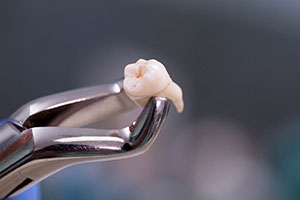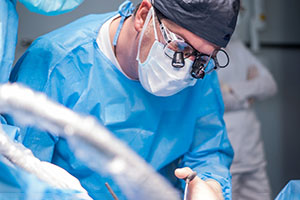
It is never your dentist’s first choice to extract a tooth. If a tooth has been broken or damaged by decay, we prefer to fix it with a filling, crown, or another treatment. However, sometimes there is too much damage for the tooth to be repaired, and an extraction is necessary to prevent additional oral health issues from persisting. If you think that a tooth extraction may be the best option for you, we’d be happy to take a look and help you through the process. Give us a call to learn more and to schedule an appointment with us.
Reasons Why Tooth Extractions Are Necessary

We always do everything in our power to help our patients keep their teeth. However, sometimes it simply isn’t the right option. Here are some of the situations where a tooth extraction may be necessary to help eliminate dental problems and benefit your oral health:
- To ensure long term success of a restoration, including dentures.
- When there’s severe, irreparable damage to the tooth.
- If a primary tooth isn’t falling out on its own.
- When a tooth is impacted and not erupting properly.
- To allow for a patient to undergo orthodontic treatment.
Wisdom Tooth Extractions

Wisdom teeth, also called third molars, are often extracted either before or after they come in. They commonly come in during the late teens or early 20s. These teeth often get stuck in the jaw (impacted) and do not come in properly. They need to be removed if they are decayed or cause pain. Some wisdom teeth are blocked by other teeth or may not have enough room to come in completely. This can irritate the gum, causing pain and swelling. In this case, the tooth must be extracted. If you need all four wisdom teeth removed, they are usually taken out at the same time.
Learn More About Wisdom Tooth Extractions
The Process of Removing a Tooth

Teeth are removed by either pulling or surgical extraction. Teeth are only ever “pulled” when they have fully emerged from the gumline. In this case, the area around the tooth is numbed with a local anesthetic, and a clasping tool is used to shift the tooth around until it breaks away from the gumline. If pulling isn’t an option, the tooth will need to be surgically removed. For this procedure, a small incision is made in the gum tissue so the tooth can be reached and removed.
During your initial visit with us, we will determine which extraction method is ideal for you. During this time, we can also discuss tooth replacement options if necessary for your unique situation.
Tooth Extraction Aftercare

You will be told not to eat or drink anything for six to eight hours after the tooth extraction procedure. You should also make sure you have someone available to drive you home after the surgery.
A cut in the mouth tends to bleed more than a cut on the skin because it cannot dry out and form a scab. After an extraction, you will be asked to bite on a piece of gauze for about 20 to 30 minutes. This will put pressure on the area and allow the blood to clot. It still may bleed a small amount for the next 24 hours and taper off after that. You must be extremely careful not to disturb this area.
You can put ice packs on your cheeks to reduce swelling after the operation. If your jaw is sore and stiff after the swelling goes away, try a warm compress. Eat soft and cool foods for a few days and then try other foods as you feel comfortable. A gentle rinse with warm salt water, started 24 hours after the surgery, can also help to keep the area clean. Use ½ teaspoon of salt in one cup of warm water. Initial healing after the teeth extraction takes at least two weeks.
You should not smoke, use a straw, or spit after your extraction surgery. These actions can pull the blood clot out of the hole where the tooth was. That causes more bleeding and can lead to a dry socket, which occurs in about 3% to 4% of all extractions.
If you have any concerns or discomfort is worsening after a few days, give us a call so we can help!